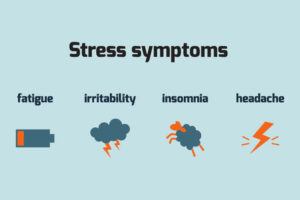Contents
- 1 Managing Stress In Organizations
- 2 Difference between healthy and unhealthy stress
- 3 Symptoms Of Stress
- 4 Identify who is most likely to be stressed In Organization
- 5 Ways to Help Employees Manage Stress In Organizations
- 5.1 Determine The Cause of Stress
- 5.2 Provide Flexible Work Schedules
- 5.3 Encourage Employees To Socialize
- 5.4 Respect Employees’ Time Away From The Workplace
- 5.5 Offer Onsite Mental Health Services
- 5.6 Communicate With Workers
- 5.7 Recognize When Employees Are Overworked
- 5.8 Implement a Wellness Program
- 6 A Word From Mantra care
Managing Stress In Organizations

Research has shown that one of the major issues affecting workers, workplaces, and the bottom line is stress in organizations. The problem of coping with stress is not trivial at work anymore. It is estimated that up to 75% of office workers are experiencing some level of distress.
One strategy for managing an organization’s team’s stress levels is the use of mindfulness-based interventions. For example, studies have found that mindfulness training can reduce anxiety, depression, and burnout among employees without harming performance on tasks. Guided by this evidence, some employers are starting to ask themselves whether it would make sense to provide these training programs to their staff.
But how do you know if your workplace is ready for mindfulness? As it turns out, there are some telltale signs that your organization is in desperate need of dedicated mindfulness training.
Do you find yourself thinking about work during off-hours? Does your company culture involve long hours at the office, or does it expect employees to check their email after hours and on weekends? Do you get frequent requests to work overtime, handle weekend work, or put in long hours?
In today’s fast-paced world, stress is inevitable. In fact, the U.S. Department of Health and Human Services estimates that 75% of all adults in the US experience a significant level of stress each year.
Difference between healthy and unhealthy stress
 But when it comes to managing stress at work, there are two types: healthy and unhealthy. Healthy stress can be motivating and energizing – a natural response to meeting difficult challenges or deadlines. Unhealthy stress, on the other hand, can lead to burnout or even depression if you don’t take steps to manage it effectively.
But when it comes to managing stress at work, there are two types: healthy and unhealthy. Healthy stress can be motivating and energizing – a natural response to meeting difficult challenges or deadlines. Unhealthy stress, on the other hand, can lead to burnout or even depression if you don’t take steps to manage it effectively.
The key is knowing how your body reacts to stressful situations so you can adjust accordingly – whether by taking time for yourself or making changes in your daily habits like eating better or exercising more.
When you’re the one managing stress, it’s important to understand what tools are available to help you successfully manage your stress levels at work. It also helps if you know how to recognize when someone else is stressed and how you can best approach them to offer support.
- Offer support to a person who is stressed by listening, asking questions, and providing resources for stress management.
- Take care of yourself by practicing self-care techniques such as exercise or meditation
- Get help from your manager or Human Resources department if necessary
Symptoms Of Stress
 Stress is a natural part of the human condition. And being aware of how it impacts you can help you manage it more effectively. Some people may experience a “fight-or-flight response” to stress, while others might experience a more subtle release of hormones that leaves them feeling depleted. If your body reacts by becoming tense or tight, or if your shoulders get stuck in your neck or upper back. You might be experiencing unhealthy stress. On the other hand, if you experience a surge of energy and feel invigorated after stressful events, chances are your response to stress is healthy.
Stress is a natural part of the human condition. And being aware of how it impacts you can help you manage it more effectively. Some people may experience a “fight-or-flight response” to stress, while others might experience a more subtle release of hormones that leaves them feeling depleted. If your body reacts by becoming tense or tight, or if your shoulders get stuck in your neck or upper back. You might be experiencing unhealthy stress. On the other hand, if you experience a surge of energy and feel invigorated after stressful events, chances are your response to stress is healthy.
Recognizing that our bodies react differently to stress can help us learn how to better manage it. Whether by making changes in our daily habits or by taking time for ourselves to recover after difficult situations. It also helps us recognize when someone else is stressed, and how best to offer our support.
Recognizing when you’re stressed begins with paying attention to your emotions, thoughts, behaviors, and overall health. For example, if your muscles are tense or tight – and you don’t feel like you’re physically able to relax – it might be a sign that your body’s “fight-or-flight” response is activated, and that you need to take steps to release some of the built-up anxiety.
Recognizing the impact stress has on our health is also helpful in recognizing when we’re stressed. For example, if you’re feeling tired or unfocused, it might be a sign that your body is releasing stress hormones that are disrupting your natural rhythms and making it more difficult for you to function at your best.
Identify who is most likely to be stressed In Organization
It is more likely that someone who works in a highly competitive workplace will be stressed. This is because they are constantly working on improving their performance relative to other people. It is more likely that someone who works in a collaborative environment will be stressed. This may be due to the need for this person to carry out tasks that require them to work alone which thus neglects teamwork and collaboration skills. Workplace conflict may also cause stress as this is a highly negative social interaction. The people who are most likely to experience stress at their workplace include those with low levels of education, those that have been employed for less than five years, and those who earn the lowest salaries.
Recognizing when someone else is stressed may require you to pay attention not just to the person’s words, but also to their body language. For example, if someone is avoiding eye contact by looking down at the floor or up at the ceiling, it might be a sign that they’re feeling overwhelmed and can benefit from your support.
Ways to Help Employees Manage Stress In Organizations

“There are many ways organizations can help employees manage stress. “
Provide wellness programs that offer activities such as yoga, meditation, and massage therapy. Workplaces are not limited to the physical location where an individual is employed. Rather, they also include all of the external events, environments, and interactions that occur outside of an organization’s walls. As such, employees may experience stressors in their lives both inside and outside of work that can undermine their productivity on the job. This makes it important for organizations to provide employees with wellness programs that are tailored to their specific needs – including activities such as yoga, meditation, or massage therapy.
According to research, 40% of adults in the US experience high levels of stress on a daily basis. Of this group, 20% reported experiencing extreme stress which is associated with increased risk for impaired cognitive performance, diabetes, cardiovascular disease, and autoimmune disorders. Stress is a rising global issue among employees in the workforce. It has been associated with absenteeism and reduced productivity on the job which ultimately results in lower work satisfaction. The impact of stress on employees also places additional pressure upon organizations to ensure that their workplace is conducive to generating personal fulfillment and wellness among employees
Determine The Cause of Stress
Differentiate between performance-based stress and non-performance-based stress. That means that in order to provide them with the most effective solution for dealing with it. It is important to identify the cause of why people are stressed out. This will provide organizations with a great amount of knowledge about how they can help their employees. It will also direct them to the most effective solutions for dealing with the stressors. For example, if someone is stressed out because they don’t enjoy their work and feel like they are putting in too much effort for not enough return. It would be best to offer more resources or support for this person to make them happy at work.
However, if someone is stressed out because their social life causes them anxiety. It would be more productive to provide coping mechanisms for social interactions rather than resources within an organization. That may not do anything to improve this person’s situation.
Provide Flexible Work Schedules
 One way that organizations can help employees manage stress is to provide flexible work schedules. This will give employees the option to take time off when they need it the most, which will reduce their risk of experiencing excessive workplace stress. It can also improve their work/life balance. Time off from work creates space for individuals to participate in activities outside of work. This can lead to benefits both inside and outside of organizations. The Organization for Economic Cooperation and Development (OECD) found that countries with more generous policies on vacation days tend to have higher health outcomes and lower costs spent on sick leave than countries with less generous policies on vacation days.
One way that organizations can help employees manage stress is to provide flexible work schedules. This will give employees the option to take time off when they need it the most, which will reduce their risk of experiencing excessive workplace stress. It can also improve their work/life balance. Time off from work creates space for individuals to participate in activities outside of work. This can lead to benefits both inside and outside of organizations. The Organization for Economic Cooperation and Development (OECD) found that countries with more generous policies on vacation days tend to have higher health outcomes and lower costs spent on sick leave than countries with less generous policies on vacation days.
Encourage Employees To Socialize
It is also important that organizations encourage employees to get together outside of work for socializing. This helps them feel a sense of camaraderie and reduces stressors that may otherwise take their toll on the individual alone. This could be done by offering incentives for participation in company-sponsored events or providing access to various community resources such as local hiking trails or parks.
Respect Employees’ Time Away From The Workplace

It is important for organizations to respect employees’ time away from the workplace. During stressful times allow them to take a vacation or sick days without fear of being penalized in any way. For example, if someone has gone through a personal loss that causes them to become extremely stressed. It should be acceptable for this person to take off work for the day or two the need arises. The company will not have any financial losses because this person will have already been collecting income during their tenure at the company. It is also important for people who are high-strung and live life at an overwhelming pace to take time off. So, they can relax and spend time with family or friends. This will help prevent their mental health from deteriorating over time which
Offer Onsite Mental Health Services
One of the most important ways organizations can manage stress among their employees is through offering onsite mental health services. This helps people without having to worry about getting to an office. It also gives them a sense of autonomy and control by giving them space. Here they can have private interactions with a therapist or psychologist. The people who use these services won’t have to worry about someone walking in on them. Especially while they’re trying to get everything off their chest. In addition, it is imperative that all offices provide internet access for those who may need help from home or from another location outside of the office.
Communicate With Workers
 Communication is so important in the workplace. The way in which employees communicate with each other can have an effect on their health, but also the mood of the office in general. Managers should take time to get to know their employees and share their own life experiences with them outside of work. They should also ask how employees are doing periodically. Especially when they notice that someone might be struggling with any sort of problem. This will help open up communication between employer and employee and unburden them of any stress they might be feeling. The more people communicate with each other, the less likely it is that mental health will suffer. Managers should show employees that they care about their well-being. By taking a vested interest in what they say and do.
Communication is so important in the workplace. The way in which employees communicate with each other can have an effect on their health, but also the mood of the office in general. Managers should take time to get to know their employees and share their own life experiences with them outside of work. They should also ask how employees are doing periodically. Especially when they notice that someone might be struggling with any sort of problem. This will help open up communication between employer and employee and unburden them of any stress they might be feeling. The more people communicate with each other, the less likely it is that mental health will suffer. Managers should show employees that they care about their well-being. By taking a vested interest in what they say and do.
Organizations should acknowledge that everyone has a life outside of the office. And that people need to recharge in order to maintain high levels of performance. Employers should have policies in place where employees are given time off without being penalized. So, they can take care of themselves. This will help prevent them from feeling drain and mentally ready after a long day at work. For example, if someone is feeling overwhelmed with their life. It might be best for them to take some time off to spend time with family or friends. This will help people get away from their jobs and prevent them from resorting to self-medication.
Recognize When Employees Are Overworked
When things become overwhelming, instead of pushing employees beyond their limits. It is important for managers and superiors to recognize when they’re overworked and need some space. This will help keep symptoms of depression and anxiety from worsening over time.
Depression symptoms can be recognized by feelings of sadness, loss of interest in favorite activities, and sleep problems. Anxiety symptoms can be recognizable through symptoms such as trouble breathing or trouble sleeping. When people don’t get the rest that they need or they push themselves too hard, these symptoms become worse.
Implement a Wellness Program
 The number of companies that are incorporating mindfulness into their corporate cultures for managing stress in organizations is on the rise. The benefits to employers and employees alike can be immense. But it’s not always easy for managers to understand how they should introduce these techniques in their own workplace. This article will help you start with your plan by explaining what types of practices may work well within your company culture. We hope these strategies will give you an idea about where to start when thinking about ways you could reduce or eliminate stress in your organization.
The number of companies that are incorporating mindfulness into their corporate cultures for managing stress in organizations is on the rise. The benefits to employers and employees alike can be immense. But it’s not always easy for managers to understand how they should introduce these techniques in their own workplace. This article will help you start with your plan by explaining what types of practices may work well within your company culture. We hope these strategies will give you an idea about where to start when thinking about ways you could reduce or eliminate stress in your organization.
Stress management through mindfulness training is beneficial to employees. By helping them manage stress levels throughout the day. Implementing this training at work will also decrease the number of stressful issues that arise throughout the company.
A Word From Mantra care
Do you want to keep your employees happy, healthy, and productive? Join our employee assistance program and get a healthier workplace.


